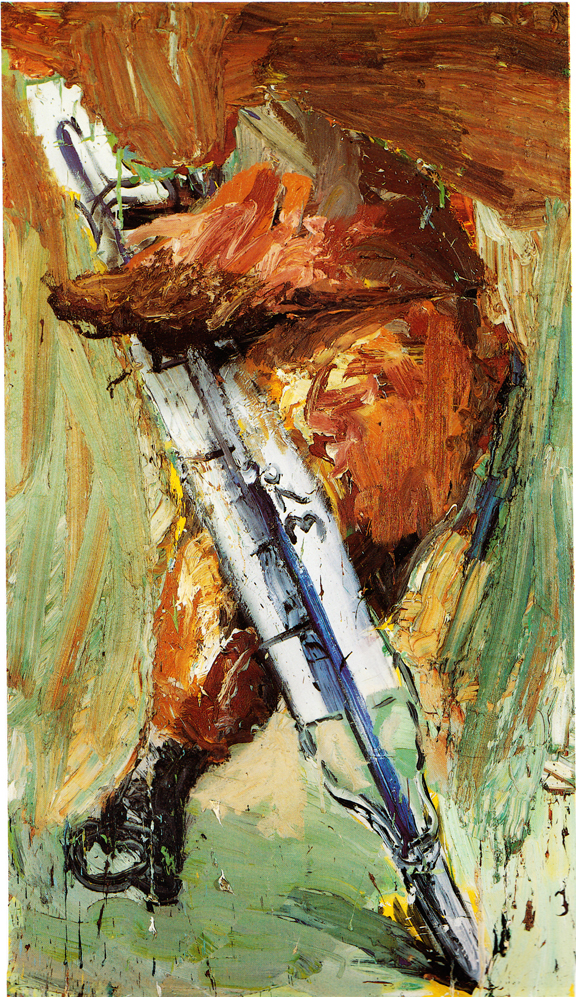Hearing the guitar riff toward the end of Boston’s 1976 rock song “Peace of Mind” from a passing car radio the other day, I was a little surprised to find myself gripped by the sound, just as when I was a teenager and predictably compelled by such things many years ago.
The musical gesture is certainly a cliché, but I listened; a cluster of chords form a simple, blocky, repeated figure. The fully cranked electric guitar and amp pump out a sound soaked in a humming spectrum of overtone distortion. All other instruments drop out during the break and let it hang excitingly in the air. The aural space around it for that moment is vast.
The brief rhythmic guitar break is a statement of the drive that’s layered up and elaborated throughout the entire song – but here it is stripped down for a minute, right to the heart of the matter. Its a sonic emotional mission statement by the long-haired, red-eyed stoner at the center of it all. He soars for a moment through an inner space of pure feeling, whipping out an energy in this riff that majestically trumps all that boring “corporate ladder” and “competition” crap.
The fully cranked electric guitar and amp pump out a sound soaked in a humming spectrum of overtone distortion. All other instruments drop out during the break and let it hang excitingly in the air. The aural space around it for that moment is vast.
As I listened, the emotional freight carried by this guitar riff called to mind something of what I encountered later in life in the loaded brush marks of Neo-Expressionist paintings. I spontaneously visualized big German pictures from the 1970s and 1980s. I first actually saw such canvases at the Toledo Museum of Art in 1988, in the traveling exhibition “Painting Refigured”. That show, organized by the Guggenheim Museum and Williams College Museum of Art, took stock of German painting between 1960 and 1988, with an emphasis on the return of figuration, but also a high concentration of the heavy-duty use of oil paint on enormous canvases. Artists in the show included Baselitz, Kiefer, Lupertz, and Polke.
I remembered standing in the museum taking in the way a particular painting featured a massive stroke from a paint-loaded brush that seemed to have been the size of a broom. The colors were mixed right on the canvas, inside the smeared mark, to make unexpected contrasts and crazy marbled streaks. Countless bleeds and clots could be found within an individual swipe of paint. This memory, as it was focused in my mind’s eye, was of a huge painting made with a single monumental mark. It read as abstraction and at the same time as an indirect representation of the presence of a giant, a towering artist who might have created this work in a flash, with a single dab. After locating and consulting the exhibition catalog for “Refigured Painting”, I couldn’t find a record of this particular painting anywhere. I realized that my memory of this piece was closely associated with a couple of untitled paintings from 1985, by Dieter Krieg. Looking at the reproductions now, I see that they are neither fully abstract nor composed of a single stroke.
One represents what looks like a chicken leg and a thermometer, and the other one depicts a huge fish hook piercing a scrap of paper with the word “idiot” scrawled on it. Looking at these in the “Refigured Painting” catalog, I realized that my recollection of a monumental single-stroke painting was a false memory, essentially an invention of my own. It didn’t exist, but was maybe accurate as an involuntary distillation of part of my impression of the show at the time. The Krieg paintings certainly were composed of the kind of heavy, fraught marks I thought of hearing that Boston song.
The macho (almost all were men) German painters whose photos appeared in the back of the catalogs (I pulled out and consulted another catalog of a similar show, “Expressions: New Art from Germany”, which included many of the same artists and toured US museums earlier in the ‘80s) were dressed and styled as tough rebels, attempting rock star glamour. Though maybe more punk rock than arena rock, from out of their black leather jackets, five o’clock-shadowed chins bore hardened scowls. A 1981 painting in “Refigured Painting” by Helmut Middendorf called “Singer” is dominated by a hunched, skinny figure holding a microphone stand, which was clearly directly copied from a photo of guitarist smashing his instrument on the stage from the cover of the Clash’s “London Calling”(1979).
As there is something signaling excess, even hinting at chaos in an overdriven distorted guitar on the edge of feedback, so there is in the touch of a gigantic brush dripping with a giant blob of mottled oil color. Each contains potential worlds within itself– and each can present a virtuosic dishing out of monumental forms, fat floating slabs for the ears or the eyes. In both cases the expression is a presumption of intensity and power deployed. In both cases the awareness of the touch of a creating hand invites one to identify and emulate by miming a swinging gesture of a brush, or a thrash at an air guitar. It’s a seductive image of mastery, full of grandiosity.
The implication of a controlling agent behind these expressions, able to propel and direct such potent stuff, suggests to me now that the appeal of these forms and the identification they offered promised compensation for adolescent male anxiety, a fulfilling of lack, an allaying of fear. It went without saying that all my male high school friends liked that guitar sound (it was beyond assumed), just as my colleagues in art school were excited about those big German smears of paint. It was a feeling. It was more than a feeling.
























